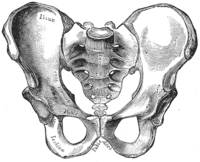
Photo from wikipedia
The clinical research described in this case report was initiated because of the recognized need for early identification of Covid-19 patients at risk of respiratory failure. We used point of… Click to show full abstract
The clinical research described in this case report was initiated because of the recognized need for early identification of Covid-19 patients at risk of respiratory failure. We used point of care ultrasound to identify diaphragm dysfunction in a spontaneously breathing Covid-19 patient. Measurements of diaphragm thickness and thickening fraction indicated diaphragm dysfunction prior to intubation while respiratory failure was not yet evident from arterial blood gas analysis. Recovery of diaphragm contractility was demonstrated within two days of controlled mechanical ventilation when the patient was switched to a pressure support mode. With recovery of the diaphragm very large fractional shortening was seen after discontinuation of rocuronium, which was associated with a reduced dynamic compliance. In conclusion, this case report illustrates the need to be aware of potential diaphragm dysfunction in spontaneously breathing Covid-19 patients. With recovery, point of care ultrasound allows repeated evaluation of diaphragm function which appears to be responsive to changes in pumonary compliance.
Journal Title: Respiratory Medicine Case Reports
Year Published: 2020
Link to full text (if available)
Share on Social Media: Sign Up to like & get
recommendations!